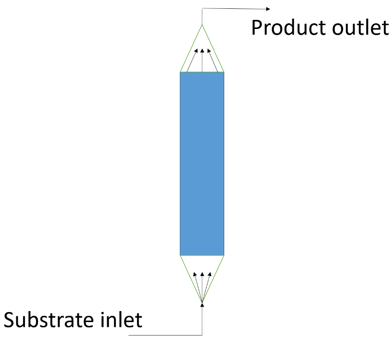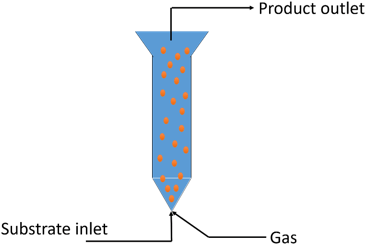This set of Enzyme Technology Objective Questions & Answers focuses on “Immobilized Enzymes – Enzyme Reactors – 3”.
1. The reactors in which all of the product is removed after fixed time is referred to as ___________
a) packed bed reactors
b) batch membrane reactors
c) stirred tank batch reactors
d) fluidized bed reactors
View Answer
Explanation: The reactors in which all of the product is removed after fixed time is referred to as stirred tank batch reactors (STRs). It consists of a tank containing a stirrer. In STRs, enzymes and substrates have identical residence times within the reactor. Packed bed reactors are those in which there is tank containing a settled bed of immobilised enzyme particles. Batch membrane reactor are those in which the enzyme is held within membrane tubes which allow the substrate to diffuse in and the product to diffuse out. Fluidized bed reactor (FBR) is one where in the flow of gas and/or substrate keeps the immobilised enzyme particles in a fluidized state.
2. The reactor wherein the flow of gas and/or substrate keeps the immobilized enzyme particles in a fluidized state is referred to as _____________
a) batch membrane reactor
b) continuous flow membrane reactor
c) fluidized bed reactor
d) packed bed reactor
View Answer
Explanation: Fluidized bed reactor is one in which the flow of gas and/or substrate keeps the immobilized enzyme particles in a fluidized state. The reactor in which the enzyme is held within membrane tubes allowing the substrates to diffuse in and the products to diffuse out I called as batch membrane reactor. Whereas continuous version of this is referred to as continuous flow membrane reactor. Packed bed reactor is type enzyme reactor which contains a settled bed of immobilised enzyme particles.
3. The reactor presented in the below diagram is ______________________

a) continuous stirred tank batch reactors
b) continuous flow membrane reactor
c) packed bed reactor
d) fluidized bed reactor
View Answer
Explanation: This reactor shows a packed bed of immobilized in the reactor with substrate inlet and action in the reactor and product outlet from the top. This type of reactor is called packed bed reactor or plug flow reactor. There are no baffles in these reactors. The reactors of this kind may be used in a recycle mode where most of the product stream is mixed with the incoming substrate stream.
4. Which kind of reactor is represented in the following diagram?

a) Fluidized bed reactor
b) Packed bed reactor
c) Continuous flow membrane reactor
d) Batch membrane reactor
View Answer
Explanation: The reactor in the diagram is fluidized bed reactor. In this type of reactor, there is an inflow of gas along with substrate so that the immobilized enzymes are in fluidized state. In order to maintain the temperature, heating or cooling coils are arranged. Along with coils, it also contains baffles which helps in maintaining the stirring efficiency. These reactors can be used in a recycle mode where most of the product stream is mixed with the incoming substrate stream.
5. The ____________ is the ratio of the length that contains sufficient enzyme to convert all the substrate at the given flow rate if the enzyme acted at its maximum velocity throughout to that of the actual reactor length necessary for complete conversion.
a) normalized time
b) normalized reactor length
c) specificity constant
d) turnover number
View Answer
Explanation: The normalized reactor length is relative to the length that contains sufficient enzyme to convert all the substrate at the given flow rate if the enzyme acted at its maximum velocity throughout and the actual reactor length necessary for complete conversion. It is given by \(l_n = \frac{lV_{max}}{F}\), where F is flow rate. Specificity constant is given by Kcat/Km. The normalized time is relative to the time that would be required to convert all the substrate if the enzyme acted at Vmax throughout, the actual time for complete conversion. Turnover number represents the maximum number of substrate molecules that the enzyme can ‘turn over’ to product in a set time.
6. For continuous flow reactors, value of Re is critical.
a) True
b) False
View Answer
Explanation: Re is reynolds number which relates to inertial force due to flow of solution to the viscous force resisting that flow. Low value of Re indicates streamlined flow, whereas high Reindicates progressively more turbulence. Re depends on the configuration of the system, at which there is a transition from streamlined flow to turbulent flow. Therefore, Re is critical. Hence the statement is true.
7. The time relative to the time required for one reactor volume to pass through the reactor is referred to as ______________
a) normalized residence time
b) normalized reactor length
c) specificity constant
d) turnover number
View Answer
Explanation: The time relative to the time required for one reactor volume to pass through the reactor is referred to as normalized residence time. It is given by trn = tF/V. The normalized reactor length is relative to the length that contains sufficient enzyme to convert all the substrate at the given flow rate if the enzyme acted at its maximum velocity throughout and the actual reactor length necessary for complete conversion. Specificity constant is given by Kcat/Km. The turnover number represents the maximum number of substrate molecules that the enzyme can ‘turn over’ to the product in a set time.
8. What does the following reaction represent?
\(\frac{V_{max}}{F}=[S]_0 X + K_m \frac{X}{1-X}\)
a) Miachelis Menten kinetics equation for enzymes
b) Miachelis Menten kinetics equation for stirred tank batch reactors
c) Miachelis Menten kinetics equation for CSTR
d) Miachelis Menten kinetics equation for immobilized enzymes
View Answer
Explanation: Stirred tank batch reactors are those in which all of the product is removed after fixed time. Whereas continuous version of this is referred to as continuous Stirred tank batch reactors. The Miachelis Menten equation in this case is given by the following equation:
\(\frac{V_{max}}{F}=[S]_0 X + K_m \frac{X}{1-X}\)
Where, Vmax = Maximum rate of reaction
Vols = Volume of substrate solution
t = Time
Km = Miachelis Menten constant
S0 = Initial substrate concentration
X = Fractional conversation = 1 – S/S0
F = Flow rate.
Sanfoundry Global Education & Learning Series – Enzyme Technology.
To practice all objective questions on Enzyme Technology, here is complete set of 1000+ Multiple Choice Questions and Answers.
If you find a mistake in question / option / answer, kindly take a screenshot and email to [email protected]
- Check Chemical Engineering Books
- Practice Biotechnology MCQs
- Practice Chemical Engineering MCQs
- Check Biotechnology Books
- Check Enzyme Technology Books
